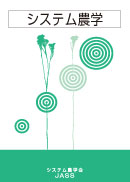All issues

Volume 3 (1987)
- Issue 2 Pages 54-
- Issue 1 Pages 48-
Volume 3, Issue 1
Displaying 1-3 of 3 articles from this issue
- |<
- <
- 1
- >
- >|
Contributed paper
-
Tatsuyoshi KOBAYASHI1987Volume 3Issue 1 Pages 48-63
Published: May 01, 1987
Released on J-STAGE: February 05, 2024
JOURNAL OPEN ACCESSThe sloped land area such as hills and mountains have been compared with those of Italy, with which land use technology is integrated, such as fruit growing and animal husbandry. Land under permanent crops and permanent grassland of Italy have long been developed to the state larger than those of Japan by 10 to 20 times in term of area per head. especially vine-yards and olive growing for the former and sheep, goats and cattles for the latter. A possibility of similar utilization of sloped land area of Japan such as formerly called SATOYAMA fuelwooded area and other some mountain districts amounting to about 3.5 - 8.2 million hectares can be considered.View full abstractDownload PDF (1187K) -
Takuro KISHINE1987Volume 3Issue 1 Pages 64-76
Published: May 01, 1987
Released on J-STAGE: February 05, 2024
JOURNAL OPEN ACCESSForests have two functions; for economy and for public service. These functions, however, are incompatible as they are mutually exclusive. That is, in the functions of forests, the economic ones (i.e. timber producing function) can be obtained only by deforesting the forests themselves while the public service ones (i.e. the function of national land conserving, of water reservoir, of recreation, of oxygen and air purifying, etc.) are available only by maintaining the supply and air forests. This paper is aimed at the development of a theory of harmonizing those two kinds of incompatible functions of forests by an artificial control. To put it more concretely, the purpose of this paper is to construct a theory of optimal division of whole forests into economic and public service usage. It is named as “Theory of Optimal Usage of Forests”. In my opinion, there are two methods to approach this aim: “law of equi-marginal utilities” and “theory of choice”. In this paper, the latter one is applied. From this point of view, the optimal usage of forests is to be defined as such a way of division of whole forests as the production transformation curve and the utility indifference curve just come in contact in the plane of economic forests versus public service forests.View full abstractDownload PDF (724K) -
- Through Farm Land Development Projects in Mihama District in Mie prefecture -Taichi YAMAMOTO1987Volume 3Issue 1 Pages 77-94
Published: May 01, 1987
Released on J-STAGE: February 05, 2024
JOURNAL OPEN ACCESSThe achievement of the total system for reorganizing regional agriculture may be expected very much in the government policies for agriculture and rural community and its models are now studied hard by economists and sociologists in agriculture. Thus, when land and water resources development projects are recently conducted, at the same time, something like its models is commonly designed for reorganizing a regional agriculture composed of its agencies and farmers. Agencies usually include those of national and local governments, agricultural cooperatives, land and water use groups. etc., which must perform their own parts of a regional agriculture. The total system, to be noticed, works on two principles of “medium or intermediate” and “organism or interrelation” which are today highlighted by regionalists and agronomists respectively. “Medium” based on a regional ecology and community is meaned by all intermediates, such as, agencies of individuals supported by a totality but not a choice of decentralization or centralization, a medium technology between traditional and modern technologies. This paper will argue that the above position of the total system presents an overly optimistic view. It neglects two important aspects of both the expectations bias under the present changeable and unforeseeable circumstance, and the internal inequality (conflict) and the external inequality of regional agriculture reorganized by the total system. The writer's recent study, therefore. raises a serious question about that the total system might be taken no further notice of these policies in the future, just as the cooperative groups for joint farming have flickered out soon after these established extensively during 1960's-1970's; because of the internal conflict (antagonism) and the external conflict of these groups. The internal conflict is an uncompatibility or inequality with the satisfaction of members' objectives and the effectiveness of the institutional-organizational framework of the total system in developing regional agriculture, that is, antagonism between individuals and their groups. This conflict is caused by its own system of infrastructure and incentives which break down when the system is overthrown (oriented totalism or collaboration), and by members' self-organized system (oriented individualism). The external conflict is a deficiency of adapting a group or organization to its environment, that is, a shortage of its own self-reforming ability met by its external change. The inequality and the deficiency are found as two facts by researching a successful group (I Agric. Coop. Inc.) and a failed group (0 Agric. Coop. Inc.) for joint farming at middle and late season citrus varieties product area in Mihama district in Mie prefecture. The two facts will be by no means special factors of joint farming, but rather be concerned about points of preventing the total system from reorganizing regional agriculture. The method of finding the facts is a way to research the groups and to examine them by the system conceptions of “Modern Organization Theories”, such as, these of C. I. Barnard, H. A. Simon, J. G. March, and H. I. Ansoff.View full abstractDownload PDF (1559K)
- |<
- <
- 1
- >
- >|